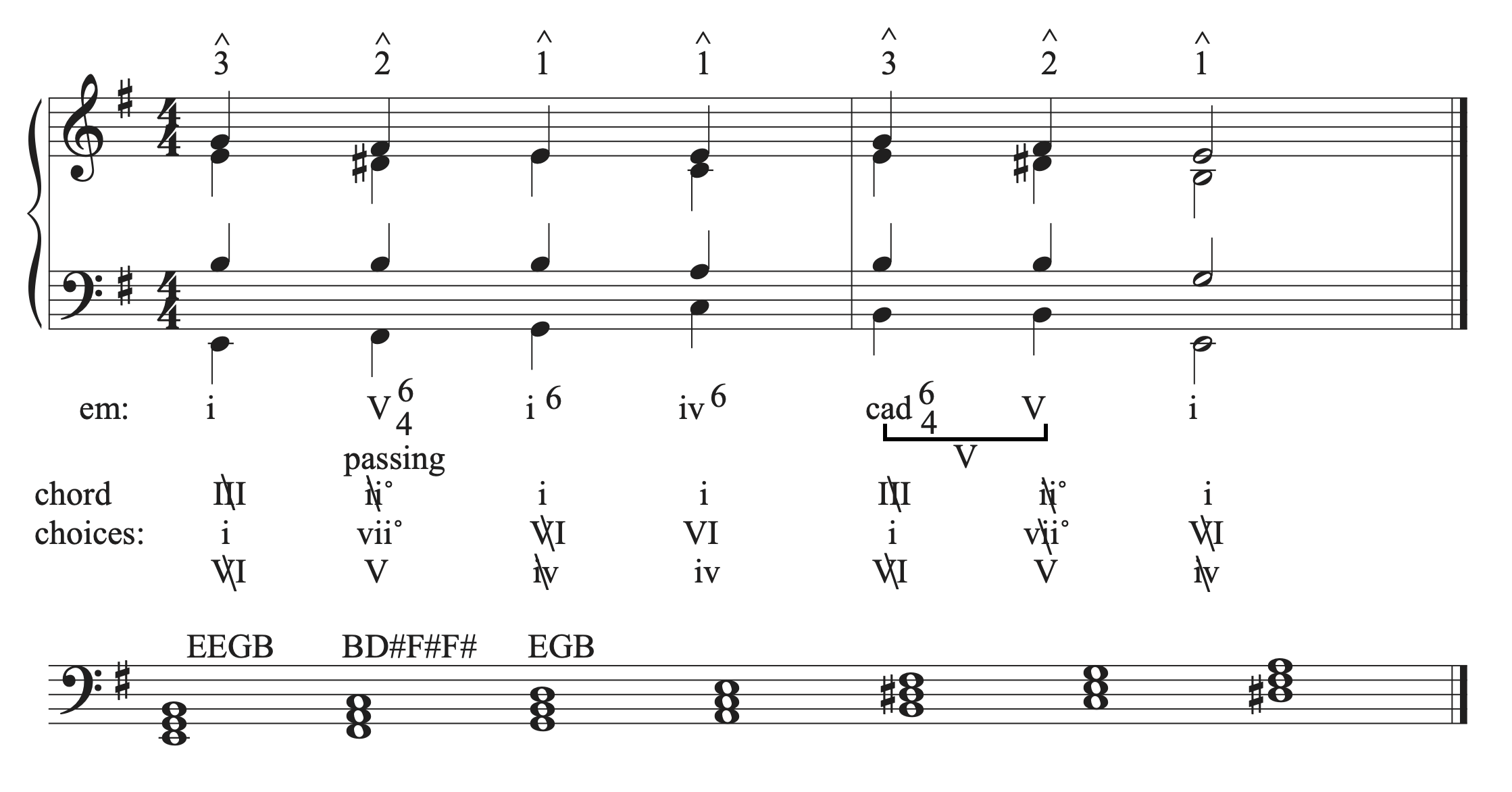11.3 Harmonizing a Melody With Triads in Inversion: Theory exercises
In addition to Workbook Chapters 11.3.1 and 11.3.2, see the example below.
Let’s look at an example to apply the guidelines for harmonizing a melody using chords in inversion.

Listen to how the melody sounds. Think about melodic phrasing, cadences, and harmonic rhythm. When do you hear chord changes? When do you hear pauses and endings in the music?
Our first steps are to label the key, write the chords used in the key in root position, and write in the scale degrees in the soprano voice.
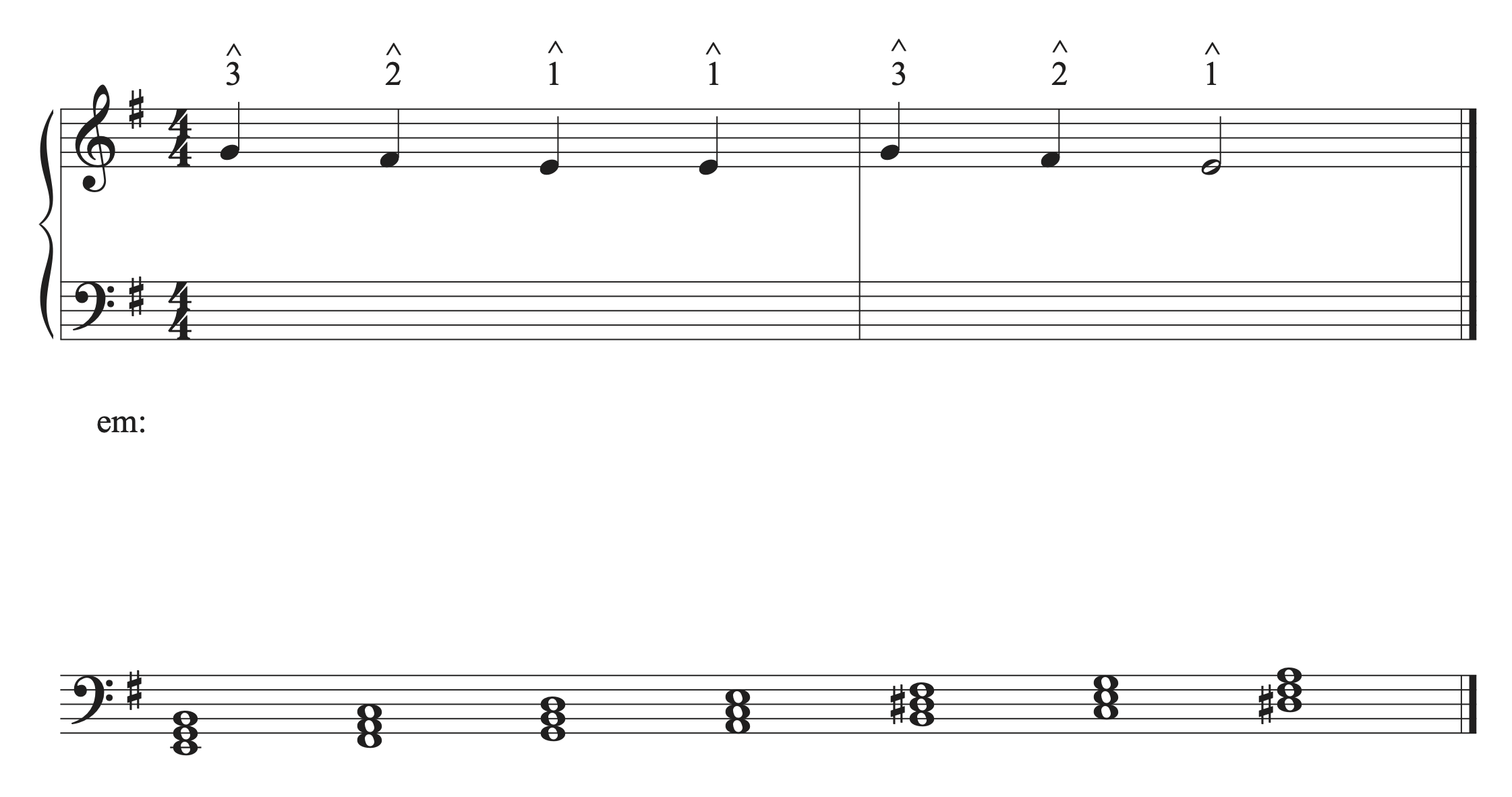
Next, create a list of the three possible chords that can be supported by each scale degree. The choice of chords support by each scale degree does not change just because we are using inversions. Each scale degree could be the root, 3rd, or 5th of a chord. Start with the chord built on the scale degree. Then count backwards two chords in the scale in order to find the next chord. Then count two chords backwards in the scale to find the last chord. Fill in the list of chord possibilities.
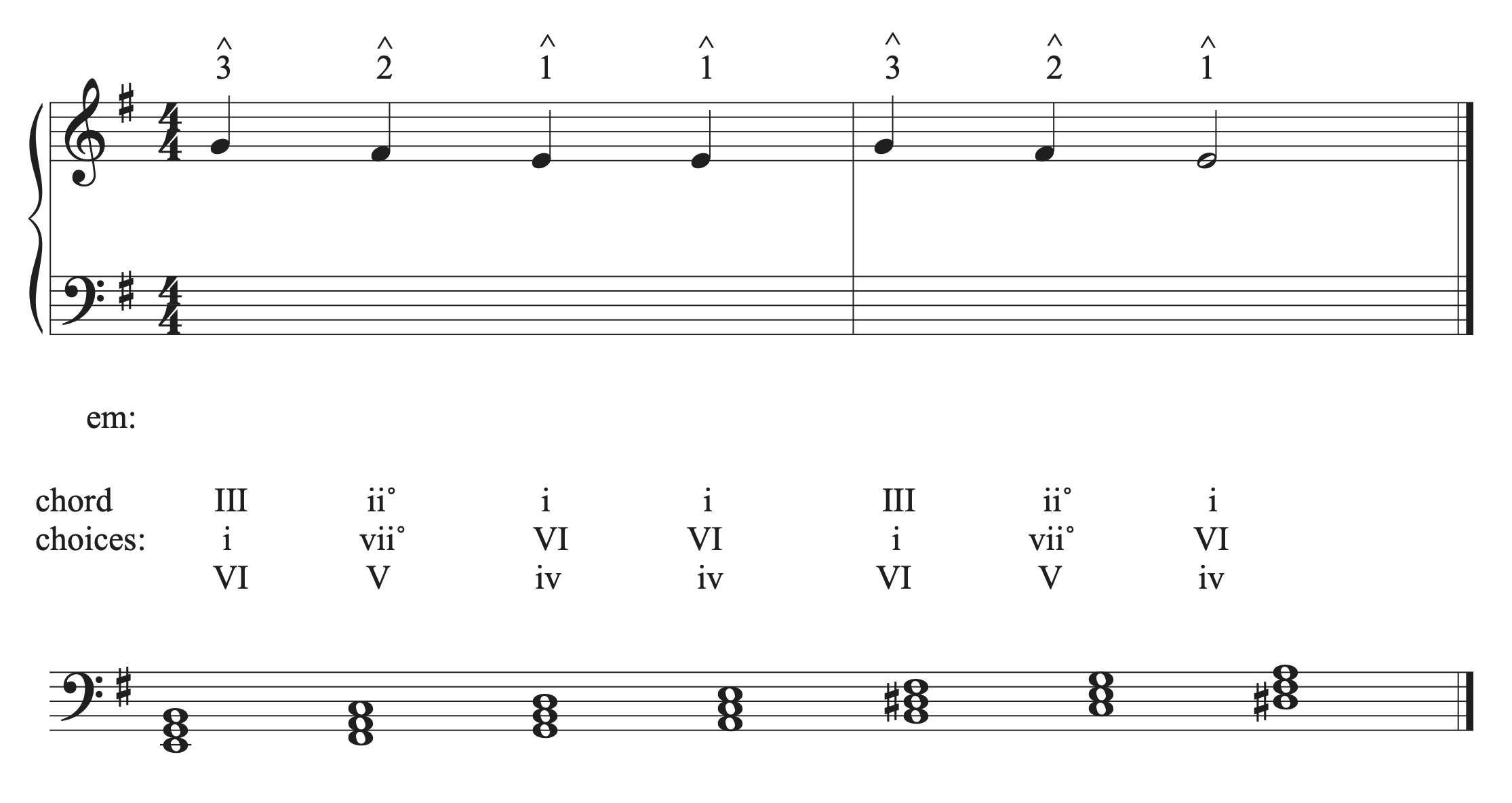
The next step is to eliminate any chords from the list that we can’t use. Determine the melodic structure, phrasing, cadences, and potential harmonic rhythm choices. Then, look at functional harmony to eliminate choices. This passage is a continuous phrase with a final cadence. We want the final cadence to be V-I. That means we can cross off any other chords at the end of the piece. Working backwards from the final V chord, neither iii or vi go directly to V, so they can be crossed off. Skipping to the beginning, we want to start on tonic, so we can cross off III and VI for the first chord. The ii˚ chord is crossed out in the next chord because it does not go to i, VI, or iv, which are the choices in the next chord. On beat 3, the VI and iv chords are crossed out because we will be arriving on that beat from either a V or vii˚ chord, and neither of those chords go to VI or iv. That still leaves many more options for chords than we saw when only using root position chords.
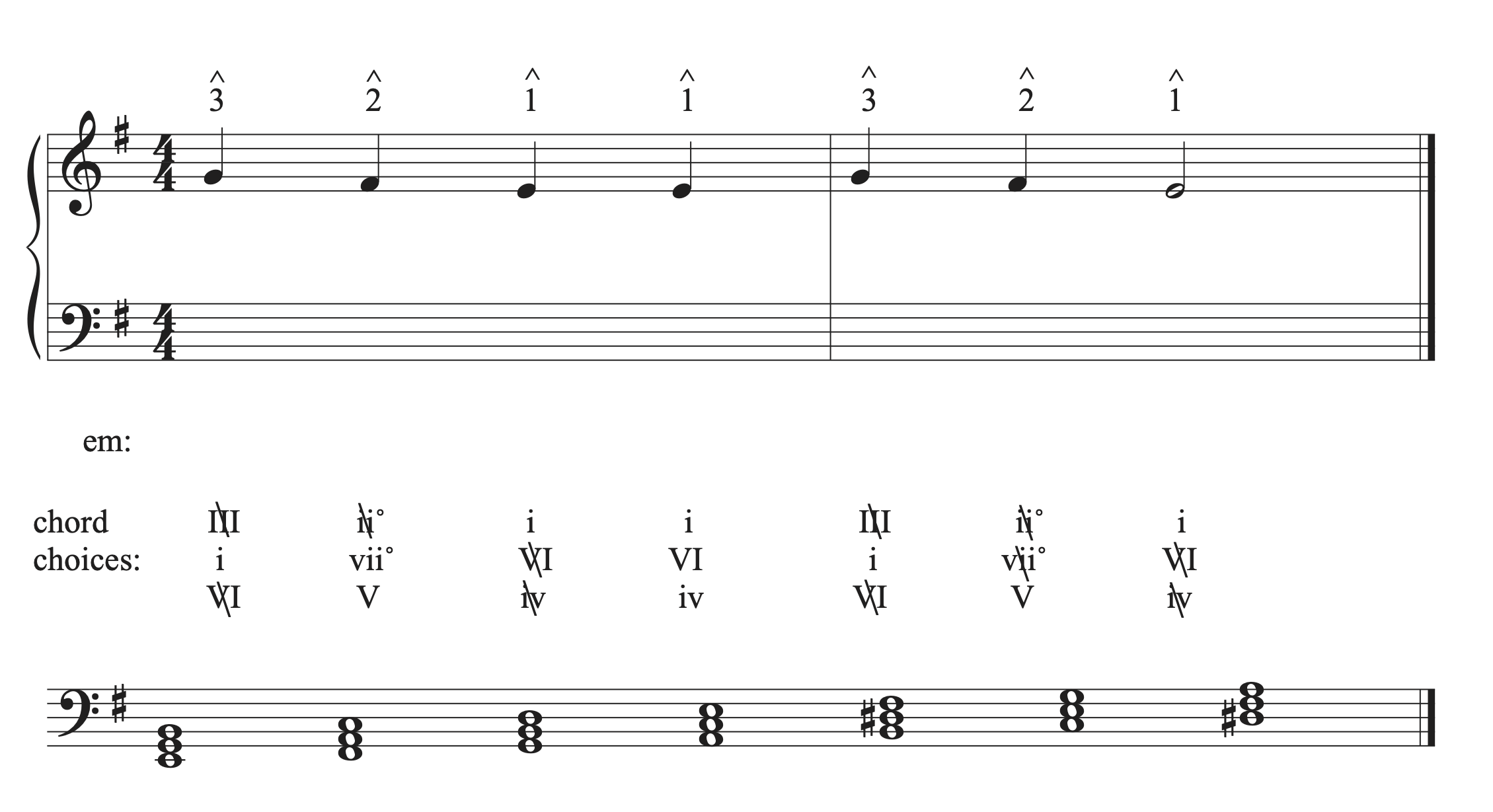
Next, we want to look for places where it is possible to use a second inversion chord. Second inversion chords are great to use in part writing progressions because if you follow the correct voice leading, you can’t create part writing errors. The most common 6/4 chord in music is the cadential 6/4 chord, so that’s a good chord to consider first. In order to have a cadential 6/4 chord, the chord must come before a V chord at a cadence and must be metrically stronger than the V chord. A cadential 6/4 would be possible to insert on beat 1 of bar 2. It is supported by tonic harmony followed by dominant harmony at a cadence, and it would be on beat 1, which is metrically stronger than V. There is only once cadence in this progression, so this is the only place a cadential 6/4 could be inserted. Generally, it is best to use this chord to strengthen the final cadence at the end of a piece.
The next second inversion chord we can look for is a pedal 6/4. Due to the way it moves during voice leading, we must see either sustained motion or upper neighbor in the soprano between 3 notes in order to be able to use a pedal 6/4. There are no examples of either type of motion in the soprano chord in this example, so a pedal 6/4 cannot be used.
Next, let’s look for places to insert a passing 6/4 chord. Due to its voice leading, a passing 6/4 needs either sustained motion in the soprano between 3 notes, lower neighbor motion between 3 notes, or passing motion between 3 notes. There are 2 places where we see passing motion in the soprano. While the soprano motion could support a passing 6/4 chord on beat 2 in bar 2, that beat is part of a cadence. The only type of 6/4 chord that can be used at a cadence is a cadential 6/4, so we can cross out that option for a passing 6/4 chord. The other place we could use the chord is in bar 1 on beat 2. Beyond having the correct motion in the soprano, the chords possible on beats 1 through 3 need to be able to support a passing 6/4 in order to use the chord. A passing 6/4 chord is most often used as a I6/4 between two V chords or a V6/4 chord between two I chords. In this example, we would be able to use the chord as a V6/4 between I and I6. We know a I6 chord must be on beat 3 because the soprano line has to step in the opposite direction of the bass.
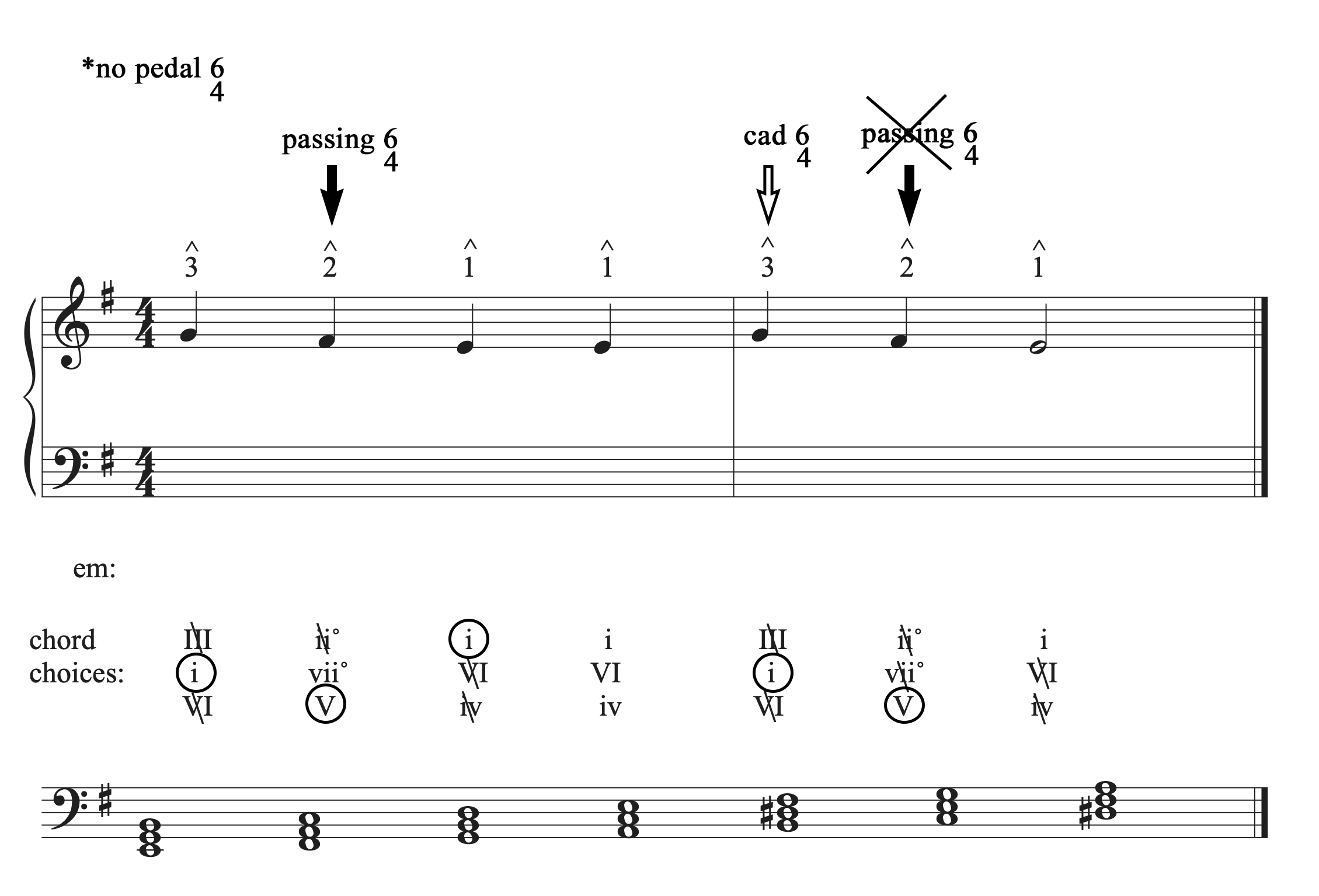
We can use the cadential 6/4 chord in bar 2 and the passing 6/4 chord in bar 1. Let’s insert those chords into our progression.
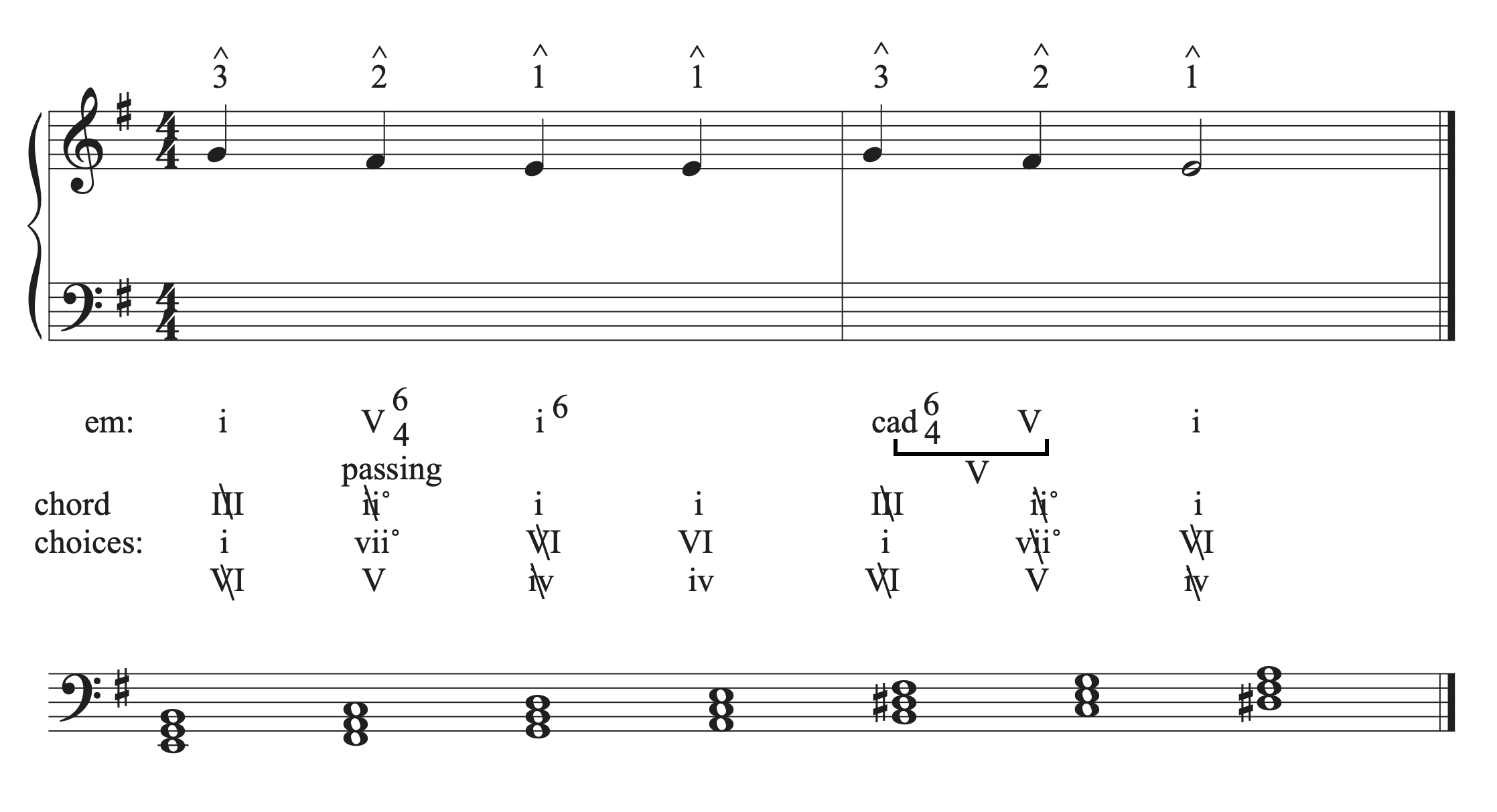
We only have 1 chord left to choose to complete the progression. Remember that the cadential 6/4 is essentially a dominant harmony. So, we need a chord that will get us from I6 to V. I and iv would both work, but iv would provide more interest, strengthen the progression with a predominant-dominant-tonic motion, and would move by step in the bass line. For these reasons, we will choose the iv chord.
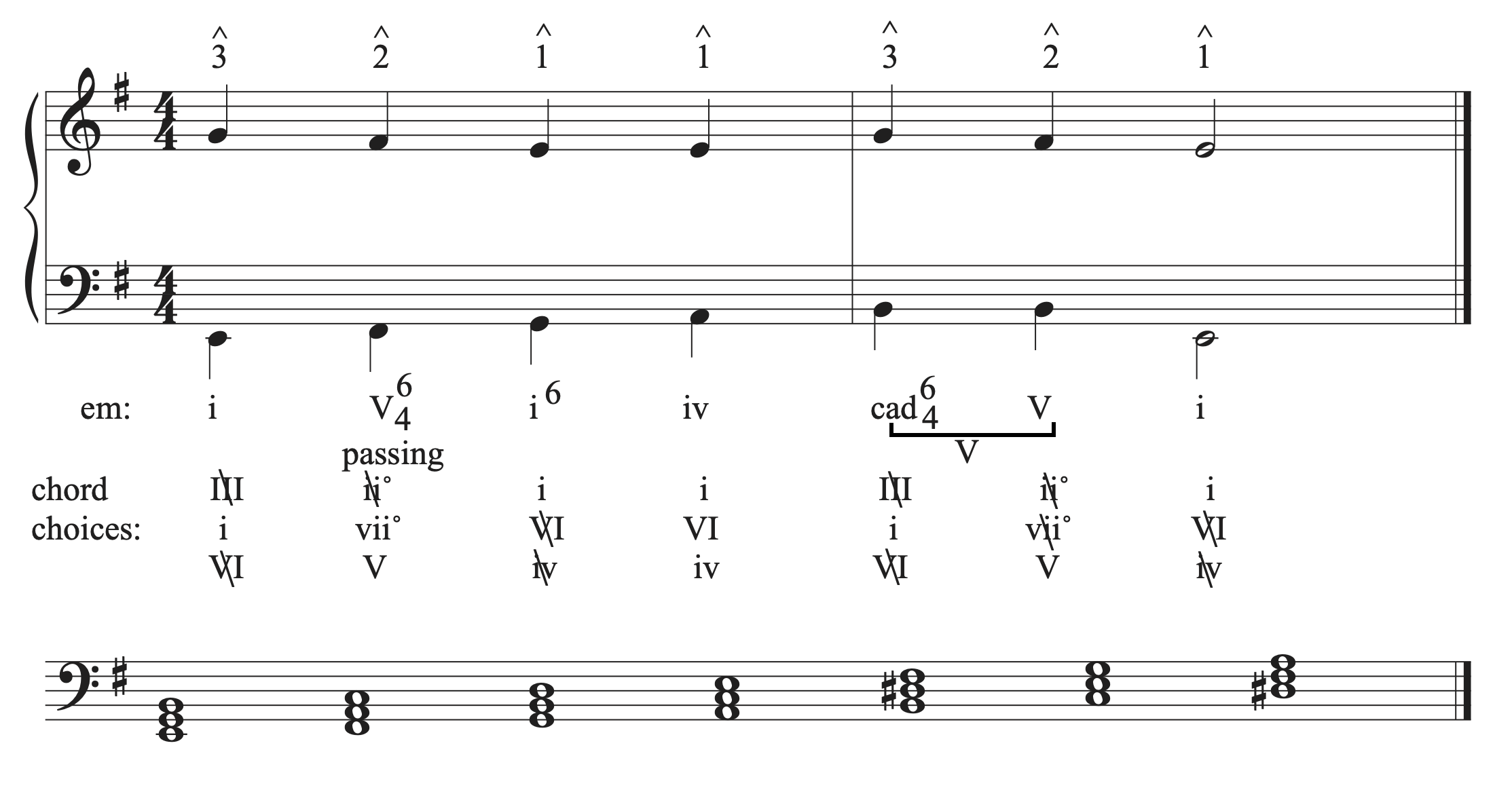
After writing in the bass line and checking it for voice leading errors against the soprano, we are ready to part write. The first progression is the passing 6/4. The bass moves up by step and the soprano moves down by step. That means one of the other voices will remain on a common tone and the other will use lower neighbor motion to connect the tonic chords. The common tone is B in the tenor. Make sure to double check that the chord is spelled and doubled correctly instead of relying just on the shape of the part writing.
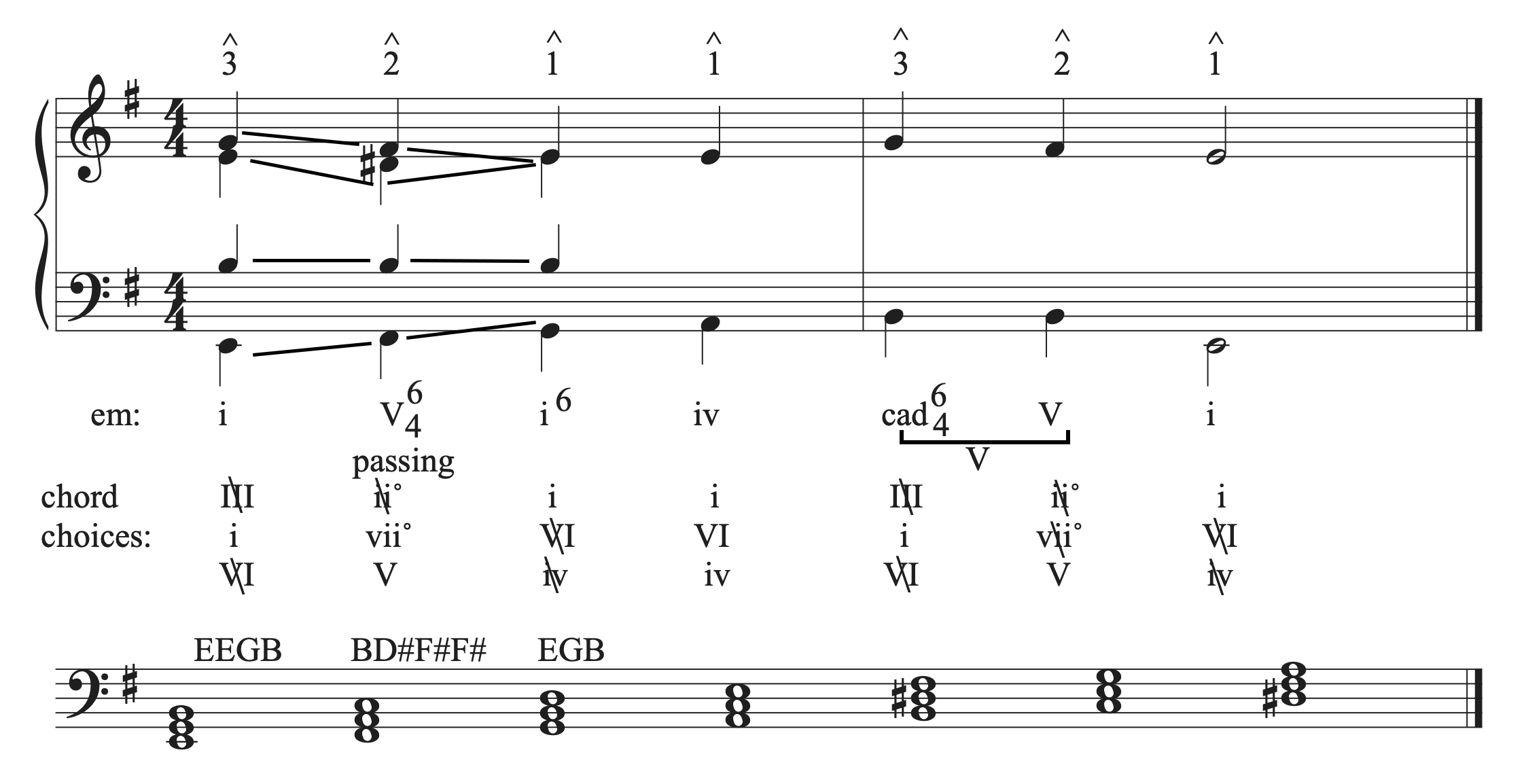
Next, we can part write the iv chord, doubling the root and moving the voices as stepwise as possible. To part write from iv to cad 6/4, remember to double the bass in any 6/4 chord.
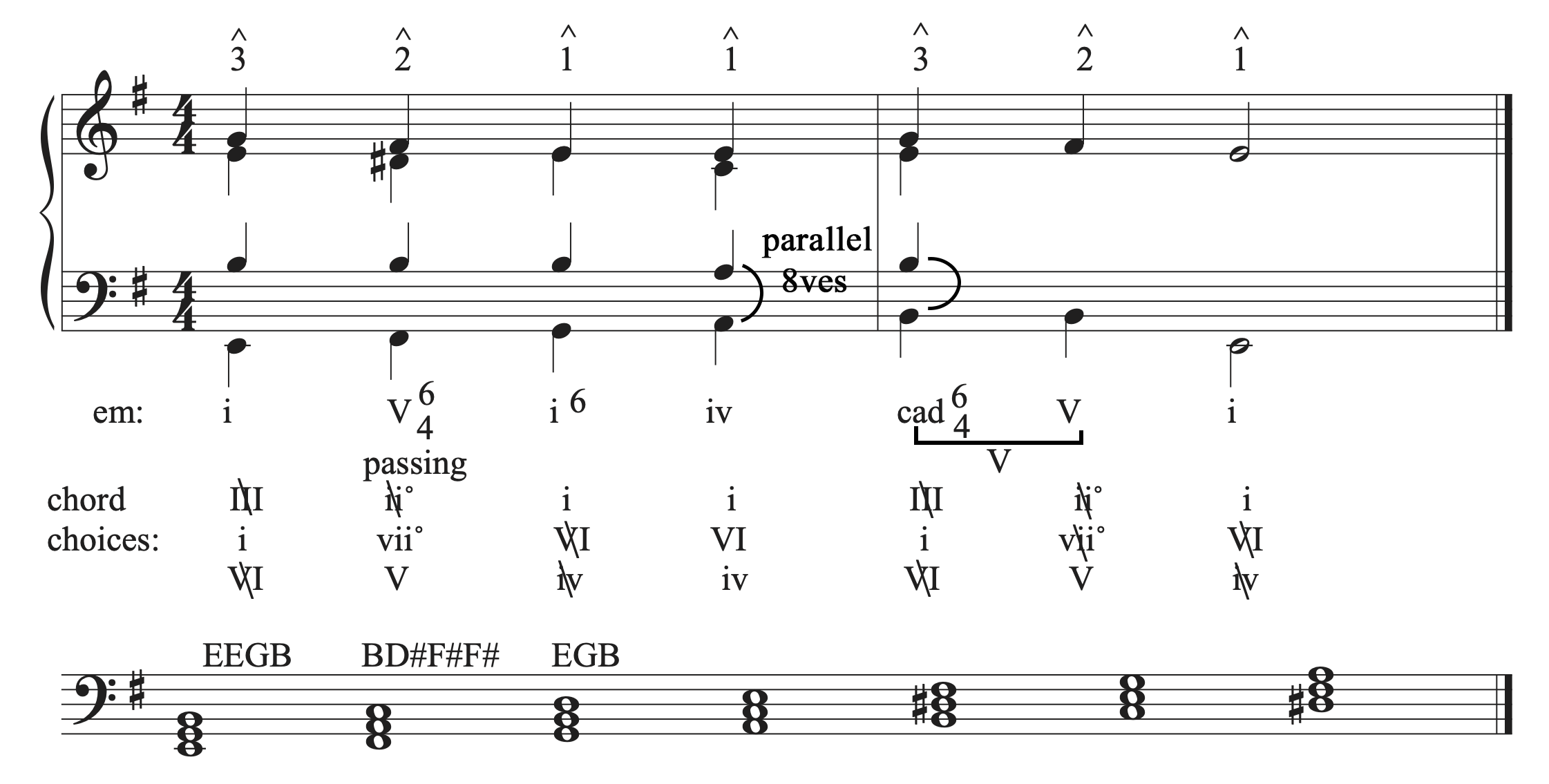
When we check for errors, we find parallel octaves between bass and tenor. No alternate voicing will fix all problems with this chord connection. When this happens, your choices are to change the bass octave to avoid the error (which won’t work in this instance), change the chord inversion, or use a totally different chord. Using another tonic chord wouldn’t be a great choice because the music would stay on tonic and never go anywhere else before cadencing. Instead, try changing the chord inversion. Remember, you can’t just insert 6/4 chords anywhere in order to avoid errors. They must be a type of 6/4 chord and must work with the melody and harmony. The best choice is using a first inversion chord because they can always substitute for their root position counterparts. If we change the chord from iv to iv6, we can eliminate the problem in the bass. Remember that you can double anything except for the leading tone in a first inversion triad.
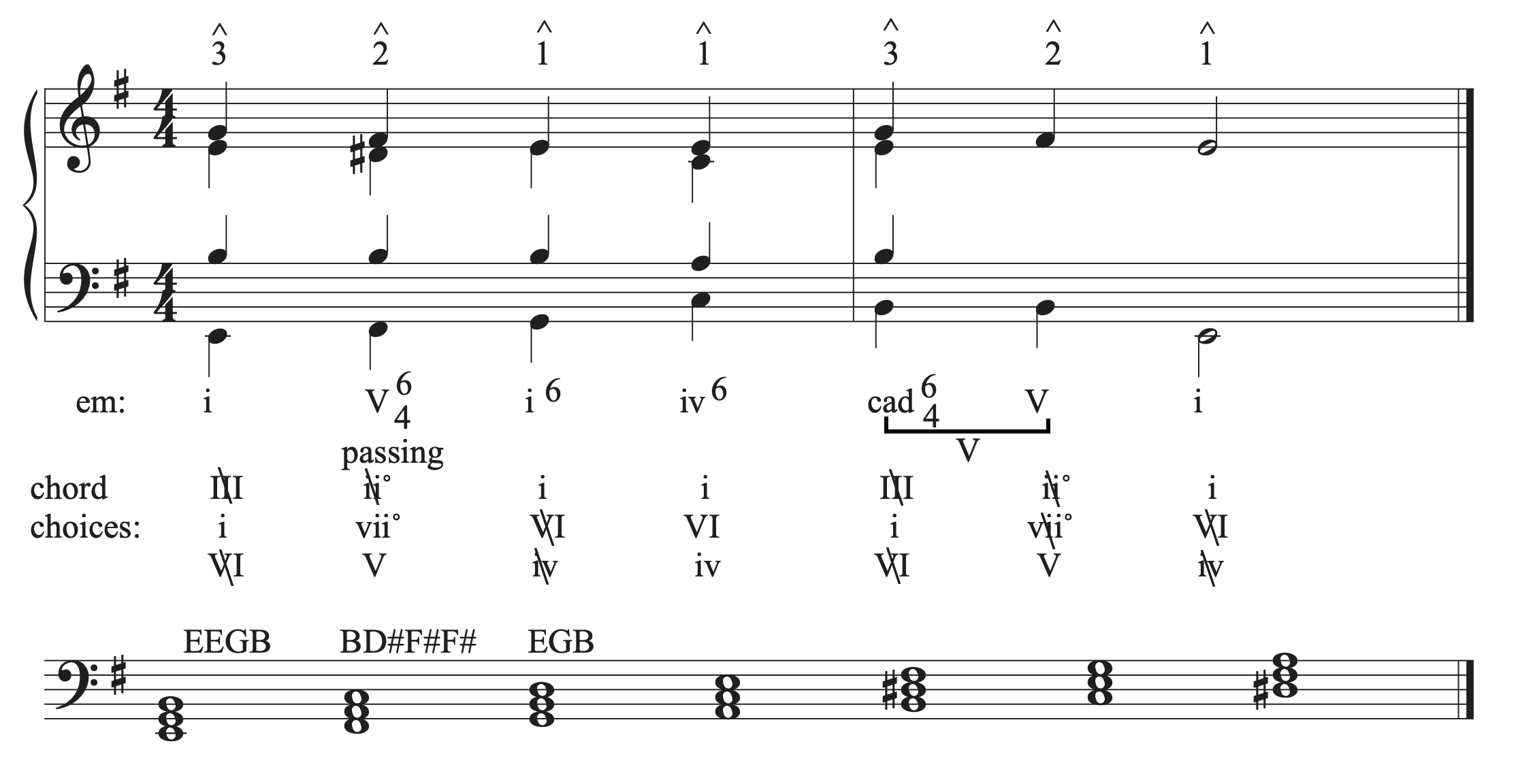
This solution doesn’t have the nice stepwise bass progression that using a iv in root position would have created. It creates a leap of a 4th, but we are able to step in the opposite direction right after the leap.
Next, we can write the cadential 6/4 chord. Remember to double the bass in the I6/4 chord. Move to the cadential 6/4 chord, using the smoothest motion with the smallest intervals possible. Then, to move to V, remember that the voice that is doubled with the bass stays a common tone between both chords. The other two voices move down by step to create 6-5 and 4-3 intervals above the bass in the two chords. To resolve the V to I, the leading tone has to move down to scale degree 5 in the alto voice in order to maintain correct doubling.

Listen to the finished example:
